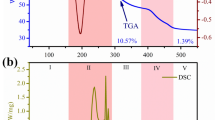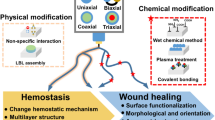Abstract
The role of metal microstructure (e.g. grain sizes) in modulating cell adherence behavior is not well understood. This study investigates the effect of varying grain sizes of 316L stainless steel (SS) on the attachment and spreading of human aortic endothelial cells (HAECs). Four different grain size samples; from 16 to 66 μm (ASTM 9.0-4.9) were sectioned from sheets. Grain structure was revealed by polishing and etching with glycergia. Contact angle measurement was done to assess the hydrophilicity of the specimens. Atomic force microscopy (AFM) and X-ray photoelectron spectroscopy (XPS) were used to characterize the roughness and surface chemistry of the specimens. Cells were seeded on mechanically polished and chemically etched specimens followed by identification of activated focal adhesion sites using fluorescently tagged anti-pFAK (phosphorylated focal adhesion kinase). The 16 μm grain size etched specimens had significantly (P < 0.01) higher number of cells attached per cm2 than other specimens, which may be attributed to the greater grain boundary area and associated higher surface free energy. This study shows that the underlying material microstructure may influence the HAEC behavior and may have important implications in endothelialization.










Similar content being viewed by others
References
Whittaker DR, Fillinger MF. The engineering of endovascular stent technology: a review. Vasc Endovascular Surg. 2006;40(2):85–94. doi:10.1177/153857440604000201.
Schatz RA, Palmaz JC, Tio FO, Garcia F, Garcia O, Reuter SR. Balloon-expandable intracoronary stents in the adult dog. Circulation. 1987;76:450–7.
Palmaz JC, Tio FO, Schatz RA, Alvardo R, Rees C, Garcia O. Early endothelialization of balloon-expandable stents: experimental observations. J Vasc Interv Radiol. 1988;3:119–24.
Palmaz JC. Intravascular stents: tissue-stent interactions and design considerations. AJR. 1993;160:613–8.
Simon C, Palmaz JC, Sprague EA. Influence of topography on endothelialization of stents: clues for new designs. J Long Term Eff Med Implants. 2000;10:143–51.
Palmaz JC, Benson A, Sprague EA. Influence of surface topography on endothelialization of intravascular metallic material. J Vasc Interv Radiol. 1999;10:439–44. doi:10.1016/S1051-0443(99)70063-1.
Fuss C, Sprague EA, Bailey SR, Palmaz JC. Surface micro grooves (MG) improve endothelialization rate in vitro and in vivo. Am J Cardiol. 2001;37(2A):70A.
Hamuro M, Palmaz JC, Sprague EA, Fuss C, Luo J. Influence of stent edge angle on endothelialization in an in vitro model. J Vasc Interv Radiol. 2001;12:607–11. doi:10.1016/S1051-0443(07)61484-5.
Van Belle E, Tio FO, Couffinhal T, Maillard L, Passeri J, Isner JM. Stent endothelialization: time course, impact of local catheter delivery, feasibility of recombinant protein administration, and response to cytokine expedition. Circulation. 1997;95:438–48.
Van Belle E, Tio FO, Chen D, Maillard L, Kearney M, Isner JM. Passivation of metallic stents following arterial gene transfer of phVEGF165 inhibits thrombus formation and intimal thickening. J Am Coll Cardiol. 1997;29:1371–9. doi:10.1016/S0735-1097(97)00049-1.
Costa MA, Sabat M, van der Giessen WJ, Kay IP, Cervinka P, Ligthart JM, et al. Late coronary occlusion after intracoronary brachytherapy. Circulation. 1999;100:789–92.
Liistro F, Colombo A. Late acute thrombosis after paclitaxel eluting stent implantation. Heart. 2001;86:262–4. doi:10.1136/heart.86.3.262.
Dibra A, Kastrati A, Mehilli J, Pache J, Oepen R, Dirschinger J, et al. Influence of stent surface topography on the outcomes of patients undergoing coronary stenting: a randomized double-blind controlled trial. Catheter Cardiovasc Interv. 2005;65:374–80. doi:10.1002/ccd.20400.
Wen X, Wang X, Zhang N. Microrough surface of metallic biomaterials: a literature review. Biomed Mater Eng. 1996;6:173–89.
Seliger C, Schwennicke K, Schaffer C. Influence of a rough, ceramic-like stent surface made of iridium oxide on neointimal structure and thickening. Eur Heart J. 2000;21(Suppl):286.
Xiao L, Shi D. Role of precoating in artificial vessel endothelialization. Chin J Traumatol. 2004;7:312–6.
Rotmans JI, Heyligers JM, Verhagen HJ, Velema E, Nagtegaal MM, de Kleijn DP, et al. In vivo cell seeding with anti-CD34 antibodies successfully accelerates endothelialization but stimulates intimal hyperplasia in porcine arteriovenous expanded polytetrafluoroethylene grafts. Circulation. 2005;112:12–8. doi:10.1161/CIRCULATIONAHA.104.504407.
Pislaru SV, Harbuzariu A, Agarwal G, Witt T, Gulati R, Sandhu NP, et al. Magnetic forces enable rapid endothelialization of synthetic vascular grafts. Circulation. 2006;114(1):I314–1318. doi:10.1161/CIRCULATIONAHA.105.001446.
Chen CS, Mrksich M, Huang S, Whitesides GM, Ingber DE. Using self-assembled monolayers to control cell shape, position, and function. Biotechnol Prog. 1998;14:356–63. doi:10.1021/bp980031m.
Sandrucci MA, Nicolin V, Biasotto M, Breschi L, Casagrande L, Lenarda RD, et al. Adhesion of Flow 2002 fibroblasts to titanium implant materials is influenced by different surface topographies and is related to the immunocytochemical expression of fibronectin. J Appl Biomater Biomech. 2004;2:169–76.
Meredith DO, Eschbach L, Riehle MO, Curtis ASG, Richards RG. Human fibroblast proliferation and cytoskeleton reactivity to characterized metal implant surfaces. Eur Cell Mater. 2004;7(1):66.
Buehler M, Harris L, Zinger O, Landolt D, Richards RG. Characterization of fibroblast adhesion on titanium model surfaces. Eur Cell Mater. 2003;5(1):24–5.
Flemming RG, Murphy CJ, Abrams GA, Goodman SL, Nealey PF. Effects of synthetic micro- and nano-structured surfaces on cell behavior. Biomaterials. 1999;20:573–88. doi:10.1016/S0142-9612(98)00209-9.
Falconneta D, Csucsb G, Grandina HM, Textora M. Surface engineering approaches to micropattern surfaces for cell-based assays. Biomaterials. 2006;27:3044–63. doi:10.1016/j.biomaterials.2005.12.024.
Kasemo B, Gold J. Implant surfaces and interface processes. Adv Dent Res. 1999;13:8–20. doi:10.1177/08959374990130011901.
Webster TJ, Ejiofor JU. Increased osteoblast adhesion on nanophase metals: Ti, Ti6Al4V, and CoCrMo. Biomaterials. 2004;25:4731–9. doi:10.1016/j.biomaterials.2003.12.002.
Cai K, Bossert J, Jandt KD. Does the nanometre scale topography of titanium influence protein adsorption and cell proliferation? Biomaterials. 2006;49:136–44.
Webster TJ, Siegel RW, Bizios R. Osteoblast adhesion on nanophase ceramics. Biomaterials. 1999;20:1221–7. doi:10.1016/S0142-9612(99)00020-4.
Standard practice for preparation of metallographic specimens. ASTM E3-95. ASTM International; 1995. p. 12.
Standard test methods for determining average grain size. ASTM E112-96, ASTM International; 2004. p. e2.
del Ro OI, Kwok DY, Wu R, Alvarez JM, Neumann AW. Contact angle measurements by axisymmetric drop shape analysis and an automated polynomial fit program. Colloids Surf A Physicochem Eng Asp. 1998;143(2):197–210. doi:10.1016/S0927-7757(98)00257-X.
Chow TS. Wetting of rough surfaces. J Phys Condens Matter. 1998;10(27):L445–51. doi:10.1088/0953-8984/10/27/001.
Anderson HL. A physicist desk reference. New York: American Institute of Physics; 1989. p. 42.
Caster DG, Ratner BD. Biomedical surface science: foundations to frontiers. Surf Sci. 2002;500:28–60. doi:10.1016/S0039-6028(01)01587-4.
Galli C, Coen MC, Hauert R, Katanaev VL. Creation of nanostructures to study the topographical dependency of protein adsorption. Colloids Surf B Biointerfaces. 2002;26:255–67. doi:10.1016/S0927-7765(02)00015-2.
Sigal GB, Mrksich M, Whitesides GM. The effect of surface wettability on the adsorption of proteins and detergents. J Am Chem Soc. 1998;120:3464–73. doi:10.1021/ja970819l.
Kidoaki S, Matsuda T. Adhesion forces of the blood plasma proteins on self-assembled monolayer surfaces of alkanethiolates with different functional groups measured by an atomic force microscope. Langmuir. 1999;15:7639–46. doi:10.1021/la990357k.
MaClary KB, Ugarova T, Grainger DW. Modulating fibroblast adhesion, spreading, and proliferation using self-assembled monolayer films of alkyl thiolates on gold. J Biomed Mater Res A 50:428–439. doi:10.1002/(SICI)1097-4636(20000605)50:3<428::AID-JBM18>3.0.CO;2-H.
Wojciak BS, Curtis A, Monhagan W, Macdonald K, Wilkinson C. Guidance and activation of murine macrophages by nanometric scale topography. Exp Cell Res. 1996;223:426–435. doi:10.1006/excr.1996.0098.
Wei S, Hong C. Protein adsorption on materials surfaces with nano-topography. Chin Sci Bull. 2007;52(23):3169–3173. doi:10.1007/s11434-007-0504-6.
Dufrene YD, Marchat TG, Rouxhet PG. Influence of substratum surface properties on the organization of adsorbed collagen films: in situ characterization by atomic force microscopy. Langmuir. 1999;15:2871–8. doi:10.1021/la981066z.
Curtis A, Wilkinson C. Topographical control of cells. Biomaterials. 1998;18:1573–83. doi:10.1016/S0142-9612(97)00144-0.
Diener A, Nebe B, Lüthen F, Becker P, Beck U, Neumann NG, et al. Control of focal adhesion dynamics by material surface characteristics. Biomaterials. 2005;26(4):383–92. doi:10.1016/j.biomaterials.2004.02.038.
Rocha LB, Goissis G, Rossia MA. Biocompatibility of anionic collagen matrix as scaffold for bone healing. Biomaterials. 2002;23(2):449–56. doi:10.1016/S0142-9612(01)00126-0.
Brunski JB. Metals. In: Ratner BD, Hoffman AS, Schoen FJ, Lemons JE, editors. Biomaterials science an introduction to materials in medicine. 2nd ed. San Diego: Elsevier Academic Press; 2004. p. 137–153.
Chadwick GA. Grain shapes and phase distribution. In: Metallography of phase transformations. New York: Butterworth and Co. Publisher; 1972. p. 160–182.
Alexander WO, Davis S, Heslop S, Reynolds KA, Whittaker VN. The origins of the strength of metals. In: Bradbury EJ, editor. Essential metallurgy for engineers. Berkshire: Thetford Press Ltd; 1985, p. 33–79.
Sutton AP, Balluffi RW. Overview no. 61: on geometric criteria for low interfacial energy. Acta Metall. 1987;35(9):2177–201. doi:10.1016/0001-6160(87)90067-8.
Doherty RD, Hughes DA, Humphreys FJ, Jonas JJ, Juul Jenson D, Kassner ME, et al. Current issues in recrystallization: a review. Mater Sci Eng A. 1997;238:219–74. doi:10.1016/S0921-5093(97)00424-3.
Mishra S, Narasimhan K, Samajdar I. Deformation twinning in AISI 316L austenitic stainless steel—role of strain and strain path. Mater Sci Technol. 2007;23(9):1118–26. doi:10.1179/174328407X213242.
McGeachie J. Blue histology—vascular system. The School of Anatomy and Human Biology, The University of Western Australia. http://www.lab.anhb.uwa.edu.au/mb140/MoreAbout/Endothel.htm. Accessed 2nd February 2008.
Plant SD, Grant DM, Leach L. Behaviour of human endothelial cells on surface modified NiTi alloy. Biomaterials. 2005;26:5359–67. doi:10.1016/j.biomaterials.2005.01.067.
Acknowledgement
The authors thank Aaron Watson, Jian Luo and Lee Cardenas for their expert technical assistance.
Author information
Authors and Affiliations
Corresponding author
Rights and permissions
About this article
Cite this article
Choubey, A., Marton, D. & Sprague, E.A. Human aortic endothelial cell response to 316L stainless steel material microstructure. J Mater Sci: Mater Med 20, 2105–2116 (2009). https://doi.org/10.1007/s10856-009-3780-7
Received:
Accepted:
Published:
Issue Date:
DOI: https://doi.org/10.1007/s10856-009-3780-7




